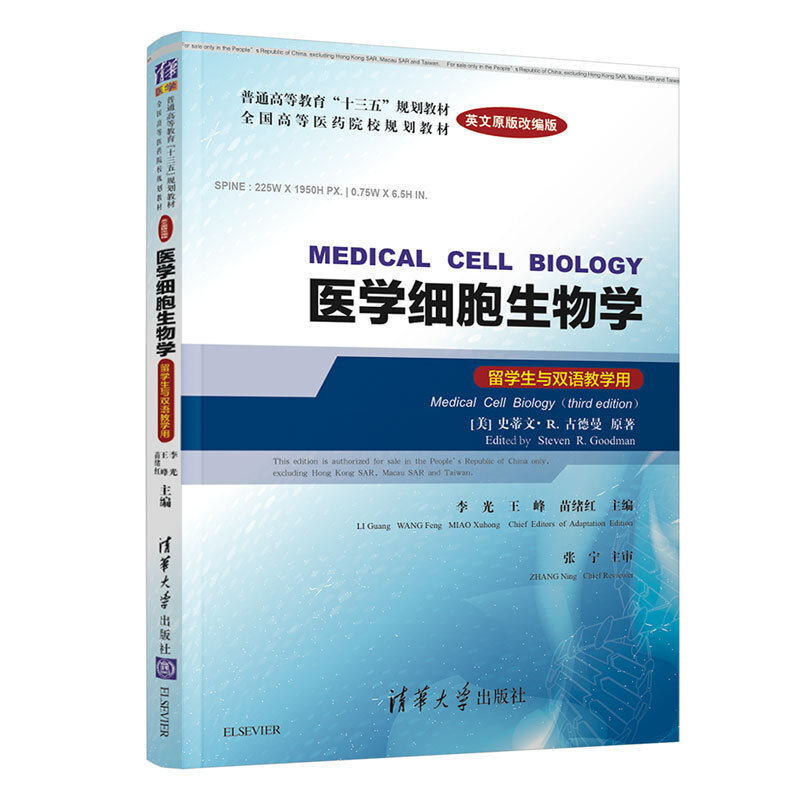
医学细胞生物学-留学生与双语教学用-英文原版改编版

- ISBN:9787302497677
- 装帧:一般铜版纸
- 册数:暂无
- 重量:暂无
- 开本:16开
- 页数:201
- 出版时间:2019-03-01
- 条形码:9787302497677 ; 978-7-302-49767-7
本书特色
Cell Biology is the most taught basic science course in medical school as it is one of the most rapidly developing subjects in science. Cell biology overlaps with molecular biology, histology, pathology, cancer biology, neuroscience, and many other major related disciplines. Having an up-to-date Cell Biology textbook that covers many functional aspects is essential for medical students to “cross the bridge” between basic sciences and clinical courses. This textbook was edited and modified from Medical Cell Biology, Steven R. Goodman ed., Elsevier, 2008. The first several chapters serve as comprehensive introductions into organelle structure, functions and gene expression. The second half of this book details many topics in medical science, including cell signaling pathways, cell cycle, programmed cell death, and cancer. New technologies such as atomic force microscopy, proteomics, and gene therapy are also covered.
内容简介
Cell Biology is the most taught basic science course in medical school as it is one of the most rapidly developing subjects in science. Cell biology overlaps with molecular biology, histology, pathology, cancer biology, neuroscience, and many other major related disciplines. Having an up-to-date Cell Biology textbook that covers many functional aspects is essential for medical students to “cross the bridge” between basic sciences and clinical courses. This textbook was edited and modified from Medical Cell Biology, Steven R. Goodman ed., Elsevier, 2008. The first several chapters serve as comprehensive introductions into organelle structure, functions and gene expression. The second half of this book details many topics in medical science, including cell signaling pathways, cell cycle, programmed cell death, and cancer. New technologies such as atomic force microscopy, proteomics, and gene therapy are also covered.
目录
MICROSCOPY: ONE OF THE EARLIEST TOOLS
OF THE CELL BIOLOGIST...................................... 1
MORE TOOLS OF CELL BIOLOGY......................... 11
SUMMARY...................................................................16
SUGGESTED READINGS........................................... 16
Chapter 2 Cell Membranes........................................... 17
THE MOLECULAR STRUCTURE OF CELL
MEMBRANE............................................................ 19
MEMBRANE TRANSPORT OF SMALL
MOLECULES........................................................... 27
SUMMARY................................................................... 31
SUGGESTED READINGS........................................... 32
Chapter 3 Cytoskeleton.................................................. 33
MICROFILAMENTS.................................................... 33
INTERMEDIATE FILAMENTS................................. 40
MICROTUBULES......................................................... 43
SUMMARY................................................................... 48
SUGGESTED READINGS........................................... 48
Chapter 4 Organelle Structure and Function......... 49
THE NUCLEUS............................................................ 50
ENDOPLASMIC RETICULUM................................. 51
THE GOLGI COMPLEX.............................................. 66
ENDOCYTOSIS, ENDOSOMES, AND
LYSOSOMES............................................................ 73
MITOCHONDRIA....................................................... 77
PEROXISOMES............................................................ 87
SUMMARY................................................................... 88
SUGGESTED READINGS........................................... 89
Chapter 5 Cell Nucleus and Gene Expression......... 90
CELL NUCLEUS.......................................................... 90
DNA REPLICATION AND REPAIR ARE
CRITICAL NUCLEAR FUNCTIONS................... 98
GENE EXPRESSION.................................................. 104
SUMMARY................................................................. 116
SUGGESTED READINGS......................................... 116
Chapter 6 Cell Adhesion and the Extracellular
Matrix........................................................... 117
CELL ADHESION...................................................... 117
INTERCELLULAR JUNCTIONS............................. 119
CELL ADHESION HAS MANY IMPORTANT
ROLES IN TISSUE FUNCTION.......................... 128
CELL ADHESION RECEPTORS TRANSMIT
SIGNALS THAT REGULATE CELL
BEHAVIOR.........................................................................133
EXTRACELLULAR MATRIX................................... 134
SUMMARY.................................................................140
SUGGESTED READINGS......................................... 141
Chapter 7 Intercellular Signaling............................. 142
GENERAL MODES OF INTERCELLULAR
SIGNALING........................................................... 142
HORMONES............................................................... 144
XII 医学细胞生物学Meeddiiccaall Ceellll Biioollooggyy
GROWTH FACTORS................................................ 146
GASES: NITRIC OXIDE AND CARBON
MONOXIDE........................................................... 148
NEUROTRANSMITTERS......................................... 150
SUMMARY................................................................. 154
SUGGESTED READINGS......................................... 155
Chapter 8 Cell Signaling Events................................ 156
SIGNALING IS OFTEN MEDIATED BY CELLSURFACE
RECEPTORS....................................... 156
RECEPTOR TYROSINE KINASES AND RASDEPENDENT
SIGNAL TRANSDUCTION...... 157
SIGNALING BY CATALYTIC RECEPTORS/
SERINE-THREONINE KINASES....................... 160
SIGNALING BY NONKINASE RECEPTORS....... 163
SIGNALING BY G-PROTEIN-COUPLED
RECEPTORS INVOLVES CLEAVAGE
OF GUANOSINE TRIPHOSPHATE TO
GUANOSINE DIPHOSPHATE.......................... 166
SIGNALING BY STEROID HORMONE
RECEPTORS REQUIRES LIGAND
INTERACTION WITHIN THE
CYTOPLASM OR NUCLEUS............................. 167
OTHER SIGNALING PATHWAYS
SIGNALING BY THE RENINANGIOTENSIN-
ALDOSTERONE SYSTEM....169
SIGNALING BY THE JAK/STAT PATHWAY..... 170
CALCIUM/CALMODULIN SIGNAL
TRANSDUCTION................................................. 170
SIGNALING BY ION CHANNEL RECEPTORS..........171
SUMMARY................................................................. 172
SUGGESTED READINGS......................................... 172
Chapter 9 The Cell Cycle and Cancer..................... 173
CELL CYCLE: HISTORY.......................................... 173
THE CELL CYCLE IS REGULATED BY
CYCLIN AND RELATED PROTEINS............... 174
MITOSIS...................................................................... 176
MEIOSIS ..................................................................... 179
SENSORS RECOGNIZE SITES OF DNA
DAMAGE............................................................... 181
CELL-CYCLE ALTERATIONS AND CANCER ..........183
SUMMARY................................................................. 184
SUGGESTED READINGS......................................... 184
Chapter 10 Programmed Cell Death........................ 185
DISTINCT FORMS OF PROGRAMMED CELL
DEATH................................................................... 186
NEUROTROPHIN RECEPTORS............................. 189
CASPASES.................................................................. 191
SIGNALING PATHWAYS THAT PROMOTE
CELL SURVIVAL.................................................. 197
APOPTOSIS AND HUMAN DISEASE................... 200
SUMMARY................................................................. 201
SUGGESTED READINGS......................................... 201
节选
Chapter 3 Cytoskeleton An intriguing feature of eukaryotic cells is the ability of extracts that contain cytosol, devoid of organelles, to roughly maintain the shape of the cell and even to move or contract, depending on how the extracts are prepared. This maintenance of structure by the cytosol arises from a complex network of protein filaments that traverse the cell cytoplasm, called the cytoskeleton. The cytoskeleton is not simply a passive feature of the cell that provides structural integrity; it is a dynamic structure that is responsible for whole-cell movement, changes in cell shape, and contraction of muscle cells—it provides the machinery to move organelles from one place to another in the cytoplasm. In addition, recent studies have provided evidence that the cytoskeleton is the master organizer of the cell’s cytoplasm, furnishing binding sites for the specific localization of ribonucleic acids (RNA) and proteins that were once thought to diffuse freely through the cytoplasm. Amazingly, the many activities of the cytoskeleton depend on just three principal types of protein assemblies: actin filaments, microtubules, and intermediate filaments (IFs). Each type of filament or microtubule is formed by a specific association of protein monomers. The dynamic aspects of the cytoskeletal structures arise from accessory proteins that control the length of the assemblies, their position within the cell, and the specific-binding sites along the filaments and microtubules for association with protein complexes, organelles, and the cell membrane. Thus, although the protein filaments and microtubules define the cytoskeleton, the participation of accessory or regulatory proteins conveys its diverse activities. This chapter discusses the structures built from the interaction of proteins ……
-

黄帝内经鉴赏辞典(文通版)
¥9.2¥28.0 -

小儿推拿秘旨
¥4.0¥9.0 -

舌诊图谱:观舌知健康
¥11.9¥39.8 -

民间针灸三百方
¥2.3¥7.0 -

中医诊断全书
¥19.2¥59.0 -

直到最后一课 生与死的学习
¥26.5¥59.0 -

本草纲目
¥27.4¥76.0 -

内外伤辨惑论-局方发挥
¥2.4¥5.0 -

勾勒姆医生
¥20.7¥59.0 -

博济医院百年1835-1935
¥26.6¥70.0 -

脉因证治
¥4.8¥13.0 -

中医入门必背歌诀
¥15.2¥38.0 -

黄帝内经素问
¥22.5¥30.0 -

中医手诊图释
¥9.2¥28.0 -

人体解剖学常用词图解(精装)
¥72.7¥158.0 -

黄帝内经
¥43.5¥68.0 -

神农本草经 本草三家合注
¥19.1¥58.0 -

针灸大成
¥29.2¥65.0 -

外科急救常识图解
¥1.7¥4.0 -

实用伤寒论方证解析
¥19.1¥58.0











